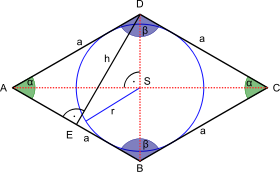- Rhombus
-
For other uses, see Rhombus (disambiguation).
Rhombus 
Two rhombiType quadrilateral, bipyramid Edges and vertices 4 Symmetry group D2, [2], (*22) Area 
Dual polygon rectangle Properties convex, isotoxal In Euclidean geometry, a rhombus or rhomb is a convex quadrilateral whose four sides all have the same length. The rhombus is often called a diamond, after the diamonds suit in playing cards, or a lozenge, though the latter sometimes refers specifically to a rhombus with a 45° angle.
Every rhombus is a parallelogram, and a rhombus with right angles is a square. (Euclid's original definition and some English dictionaries' definition of rhombus excludes squares, but modern mathematicians prefer the inclusive definition.)[1]
The English word “rhombus” derives from the Ancient Greek ῥόμβος (rhombos), meaning spinning top. The plural of rhombus can be either rhombi or rhombuses.
Contents
Characterizations
A convex quadrilateral is a rhombus if and only if it is any one of the following:[2][3]
- a parallelogram with four equal sides
- a parallelogram in which at least two consecutive sides are congruent
- a quadrilateral with four congruent sides
- a parallelogram in which a diagonal bisects an interior angle
- a quadrilateral in which each diagonal bisects two interior angles
- a parallelogram in which the diagonals are perpendicular
- a quadrilateral in which the diagonals are perpendicular and bisect each other
Properties
Every rhombus has two diagonals connecting pairs of opposite vertices, and two pairs of parallel sides. Using congruent triangles, one can prove that the rhombus is symmetric across each of these diagonals. It follows that any rhombus has the following properties:
- Opposite angles of a rhombus have equal measure.
- The two diagonals of a rhombus are perpendicular; that is, a rhombus is an orthodiagonal quadrilateral.
- Its diagonals bisect opposite angles.
The first property implies that every rhombus is a parallelogram. A rhombus therefore has all of the properties of a parallelogram: for example, opposite sides are parallel; adjacent angles are supplementary; the two diagonals bisect one another; any line through the midpoint bisects the area; and the sum of the squares of the sides equals the sum of the squares of the diagonals (the parallelogram law). Thus denoting the common side as a and the diagonals as p and q, every rhombus has
Not every parallelogram is a rhombus, though any parallelogram with perpendicular diagonals (the second property) is a rhombus. In general, any quadrilateral with perpendicular diagonals, one of which is a line of symmetry, is a kite. Every rhombus is a kite, and any quadrilateral that is both a kite and parallelogram is a rhombus.
A rhombus is a tangential quadrilateral.[4] That is, it has an inscribed circle that is tangent to all four of its sides.
Origin
The word rhombus is from the Greek word for something that spins. Euclid used ρόμβος (rhombos), from the verb ρέμβω (rhembo), meaning "to turn round and round".[5][6] Archimedes used the term "solid rhombus" for two right circular cones sharing a common base.[7]
In mathematics
- The dual polygon of a rhombus is a rectangle.
- One of the five 2D lattice types is the rhombic lattice, also called centered rectangular lattice.
- Identical rhombi can tile the 2D plane in three different ways, including, for the 60° rhombus, the Rhombille tiling.
- Three-dimensional analogues of a rhombus include the bipyramid and the bicone.
Area formulas
As for all parallelograms, the area K of a rhombus is the product of its base and its height. The base is simply any side length a, and the height h is the perpendicular distance between any two non-adjacent sides:
The area can also be expressed as the base squared times the sine of any angle:
or as half the product of the diagonals p, q:
or as the semiperimeter times the radius of the circle inscribed in the rhombus (inradius):
Inradius
The inradius can be expressed in terms of the diagonals p and q as[4]
References
- ^ Weisstein, Eric W., "Square" from MathWorld. inclusive usage
- ^ Zalman Usiskin and Jennifer Griffin, "The Classification of Quadrilaterals. A Study of Definition", Information Age Publishing, 2008, pp. 55-56.
- ^ Owen Byer, Felix Lazebnik and Deirdre Smeltzer, Methods for Euclidean Geometry, Mathematical Association of America, 2010, p. 53.
- ^ a b Weisstein, Eric W., "Rhombus" from MathWorld.
- ^ Rhombos, "A Greek-English Lexicon", Liddel and Scott, at Perseus
- ^ Rhembo, "A Greek-English Lexicon", Liddel and Scott, at Perseus
- ^ http://www.pballew.net/rhomb.
External links
- Parallelogram and Rhombus - Animated course (Construction, Circumference, Area)
- Rhombus definition. Math Open Reference With interactive applet.
- Rhombus area. Math Open Reference Shows three different ways to compute the area of a rhombus, with interactive applet.
Categories:- Quadrilaterals
- Greek loanwords
Wikimedia Foundation. 2010.







